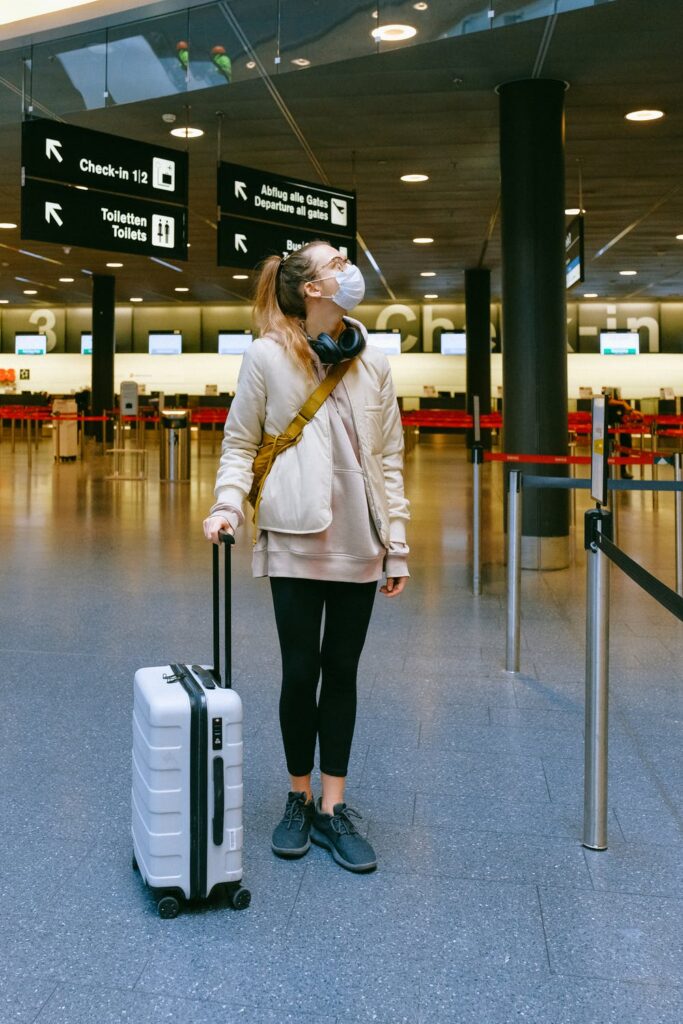
I’m thinking about leaving on a jet plane, and finally getting back in the air again. For someone who used to be on the road three weekends out of four, the lost year of pandemic has been a tough one in more ways than one. So it’s been a bit concerning to see increasing reports of…let’s call it friction at airports and on planes. We’ve seen everything from gate brawls to nasty screaming fights to violent shoving in aisles and more. People are getting cranky over wearing masks, not wearing masks, standby seats, connecting flights, you name it. The end result? Not just hurt feelings, but physical injuries. With so many of these incidents occurring past airport security where ordinary self-defense tools like pepper spray are restricted, the personal protection strategies that apply are a little different from the rest of the world. A few that you might want to think about next time you decide to travel:
Don’t fly at all. As air travel has become more expensive with more hassle, not to mention the risk of lost luggage, opting out has become more popular. For shorter jaunts, you might actually spend less time getting to where you’re going if you decide to drive or take some other transportation. For further travel, getting there might end up being part of the trip as you get to see the scenery, stop at the tourist traps, and maybe add a few visits with friends along the way. While there are other dangers when going by other forms of mass transportation or by driving your way through unfamiliar territory, not being in an airport or on a plane is certainly an effective way to avoid the dangers of being in an airport or on a plane. If you are able to afford the time and perhaps the additional cost, then it can be a viable way of avoiding a space that you know will be filled with especially stressed and potentially violent people.
Of course, sometimes flying is the only way, particularly when you’re on a tight schedule or want to maximize your time at your destination, or if other forms of transportation end up being more expensive for your situation. When that’s the case, being in an airport or on a plane is a really good time to be a rule-follower. I know I’ve talked a lot about speaking up for yourself and doing what’s right even when it’s hard, but I’m going to argue now that for your safety, sometimes doing what’s right means being quiet and compliant. That’s an extremely context-sensitive stance; don’t mistake me saying it now for saying that you should always be quiet and compliant and that it’s a route to guaranteed safety. I’m saying specifically that when you are surrounded by a crowd of folks who are already a bit more on edge than usual, in a restricted environment, that it’s perhaps not the best time to make a fuss about complying with rules that are set by an outside force or to make a fuss about people who aren’t. The airline staff you are interacting with are literally just trying to do their jobs, so let them. You can’t change policies by arguing with them, and you aren’t helping when you argue on their behalf. Instead, be like my favorite Disney song and Let. It. Go.
Along the same lines, do what you can to avoid the touchiest times and places you anticipate. That can mean avoiding adding on to your own stress and short temper by making sure that you arrive early or on time, and that you have all of your logistics in place and aren’t scrambling to find your tickets or confused by procedures to check luggage or get through the security line. It can also mean taking on an attitude of resignation towards the inevitable snags and delays, rather than getting caught up in understandable annoyance that you take out on someone else who is similarly on the edge of anger. Externally, you might find it productive to not participate in the shoving fest of getting on or off a plane, to pack carefully to not have to fight over carry-on luggage space, or to find other ways of reducing your stress and reducing your need to be somewhere you could be the target of someone else’s stress. If you don’t have to rush to make your flight connection, for instance, maybe you can take that window seat and wait to get off the plane. Similarly, hanging out in an airport lounge or restaurant might be preferable to being part of the chaos at the gate of a delayed flight. Either way, don’t discount the power of pretending not to see and refusing to insert yourself into a potentially difficult situation.
Finally, because we can’t always keep ourselves out of trouble for whatever reason, including because sometimes trouble finds us, it’s important to learn skills that you can apply when you aren’t where you can have your normal weapons. We often talk in the self-defense world about verbal skills and deescalation strategies, but can you concretely articulate what those look like and how to use them? Have you practiced exact words you can use in different situations to extract yourself from difficulty, if not actually defuse impending violence? Have you learned and do you practice hands-on fighting skills that don’t require additional tools? They might not be as effective as when you do have tools available, but they sure beat having nothing at all to fall back on. Related, improvised weapons might theoretically be your jam, but have you done more than read about them on the Internet? Have you learned the skills to make them successful in use? Have you actually put them together and tried them on appropriate targets? I can tell you from experience (and you can see on my inRange videos) that it isn’t always as easy or effective as it looks on paper.
Or, you know, stay home. It’s probably going to be safer anyway, just think about all the fun you’ll be missing and whether that’s worth it.




